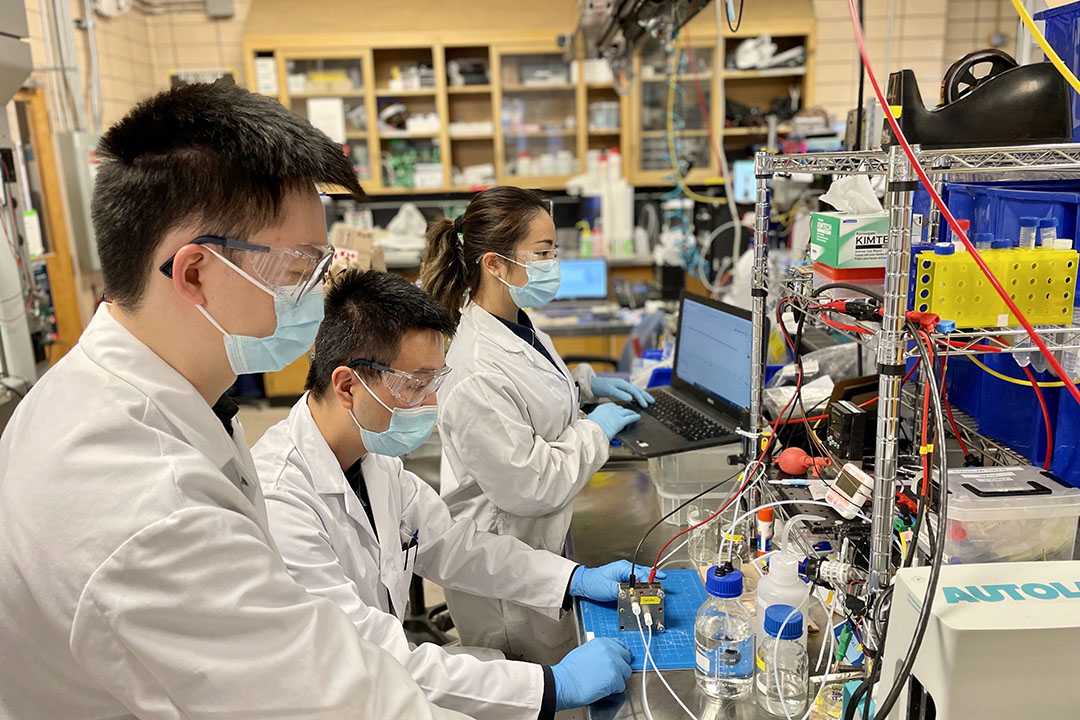A team of researchers at U of T recently won 250,000 USD of seed funding in a competition run by XPrize, a foundation that holds competitions where teams come up with innovative solutions to real world problems. Team E-quester, a U of T Engineering team led by Shijie Liu, Celine Xiao, and Yi Xu, including student teammates Rui Kai Miao and Colin O’Brien, was among the 23 student teams that won prize money for their innovative carbon removal technologies.
This year’s competition is backed by Elon Musk, the CEO of SpaceX and Tesla, who set aside 100 million USD to fund the most innovative solutions. The four-year global competition was launched on earth day — April 22, 2021 — and is designed for climate innovators who can create solutions that involve capturing carbon dioxide directly from the air or oceans and storing it away safely and sustainably.
XPrize received 195 project proposals from teams in 44 countries. E-quester was one of 18 student-led teams that received 250,000 USD to jumpstart their carbon removal project for the next phase of the competition. Five other student teams received 100,000 USD to develop technologies toward measurement, reporting, or verification of carbon removal solutions.
A more sustainable method for carbon removal
The student team members — Liu, Xiao, Miao, and O’Brien — are very excited to be a part of this new project at its inception. Xu, their project mentor, brings a lot of expertise in electrochemical systems design to the team, and Team E-quester advisors — Prof. Sinton, Prof. Sargent, Dr. Alex Ip, and Dr. Christine Gabardo — are able to provide guidance and support in terms of obtaining the required resources. Liu, Xiao, O’Brien, Gabardo, and Ip were also members of a startup company called team CERT that was a finalist in a previous XPrize competition.
What sets E-quester’s technology apart from their competitors’ is their novel electrochemical regeneration system. In this system, the alkaline solution used to capture the carbon dioxide is regenerated and recycled after the captured carbon dioxide is released. The pure carbon dioxide released can then be processed for subsequent utilization or storage. This process is entirely powered by renewable electricity.
In an email interview with The Varsity, Xiao, one of the three team leaders, further explained that “[the team’s] technology generates an alkaline solution that can chemically capture [carbon dioxide] directly from the air. The captured [carbon dioxide] stays in the solution while clean, [carbon dioxide-free] air leaves the system and returns to the atmosphere.”
“Traditional carbon capture methods require high temperatures to release the captured [carbon dioxide] from the capture solution. This thermal energy usually comes from combustion of fossil fuels which emit [carbon dioxide] in the process,” wrote Xiao. Furthermore, she added that since their technology is electricity powered, they can use renewable resources to minimize their carbon footprint and increase their energy efficiency.
Direct carbon capture (DAC) technology is an effective method that has been demonstrated for efficient carbon removal and is considered key for an energy system with net zero emissions — that is, a system where the amount of carbon dioxide emitted into the atmosphere is equivalent to the amount removed.
However, current DAC methods are extremely expensive due to their operational and storage costs, which prevents their widespread use. “We wanted to leverage our lab’s expertise in electrochemistry and mechanical engineering to design a system that could be more energy efficient than existing systems,” wrote Xiao.
The success of projects like this is highly dependent on collaboration and the exchange of ideas. The E-quester team members are aware of their individual roles and expertise. They trust each other to put their best foot forward and are comfortable seeking advice from their mentors.
Moving forward
Xiao wrote that the team will use the majority of the funding they’ve received to invest in equipment and in improving their concept. As the competition progresses, they will aim to demonstrate the entire carbon removal process, from the point where it exists in the air to when it is put in the ground for permanent storage.
Winning the 250,000 USD prize has given the team a lot of financial reassurance and drive to keep progressing forward in the competition. “To be honest, the most challenging part of this project is yet to come,” admitted Xiao. She foresees that things will change once they transition from working on lab scale prototypes to full scale capacity, and that many areas of the system can be improved in preparation as they implement their project.
A competition like this not only aims to support creative climate change innovators around the world, but also highlights the urgency for immediate action toward the global climate crisis. Xiao hopes that large-scale global competitions like this one will inspire innovative climate change solutions and attract more funding into this field of research. The XPrize competition will also serve to educate and start conversations among the public about what we can do to minimize the impact of climate change.
The team’s progress can be followed at e-quester.com.


